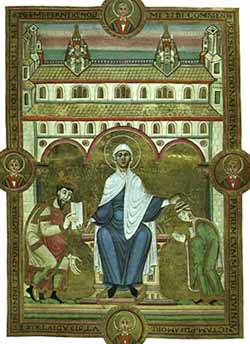The Salian Dynasty (... continued)

On May 6 1012 Heinrich II donated a precious
illuminated manuscript made at the Benedictine Abbey, to celebrate the consecration of Bamberg Cathedral.
This famous Book of Pericopes (passages from the Gospels) comprises passages selected for use during the
celebration of Festive Masses, and represents the pinnacle of Reichenau art, in script and decoration,
size and external design.
|
His son and successor, Henry III (reigned 1039–56), inherited three of the five German stem (tribal)
duchies. He augmented his power of possession with the use of the ministerials, close cooperation with
German churchmen, and virtual control of the papacy and thereby formed the strongest central government
in the history of the medieval German empire. Henry's son succeeded him as Henry IV (reigned 1056–1106)
at age six. After a minority, troubled by the conflicting ambitions of lay and ecclesiastical magnates,
the young king became engaged in a struggle with the reformed papacy under Pope Gregory VII (reigned
1073–85), who sought to free the church from any dependence on the emperor for its German lands. Their
dispute over the control of appointments to ecclesiastical office initiated nearly two centuries of
papal-imperial conflict. After Gregory excommunicated him and had him dethroned in 1076, Henry came to
terms with the pope at Canossa (January 1077). Henry IV had to meet many revolts of German princes; the
last, in 1105, was led by his son, who succeeded him as Henry V. During his reign (1106–25), Henry V made
peace with the papacy. The Salian line became extinct when he died without an heir.
Henry III, Holy Roman Emperor
Born in 1017, he became king of Germany upon the death of his father, the emperor Conrad II on June 4,
1039. He was crowned emperor by the Pope in 1046. Henry was married in 1036 to Canute the Great's daughter
Gunhilda. Early on Henry's father emperor Conrad II had arranged fief with Canute to have him rule over
some parts of northern Germany and in turn to have their children get married. After the marriage took
place at the earliest legal age, Gunhilda died just two years later at the Adriatic Coast on an imperial
journey.
Henry was re-married in 1043 to Agnes de Poitou, daughter of duke of William V of Aquitaine. They had a
son Henry IV, Holy Roman Emperor and a daughter, Judith of Swabia.

Emperor Henry III and his wife, Agnes in the
illustration of the Codex aureus Spinensis from 1046
|
In 1046 Henry held royal/imperial courts at Merseburg and Meissen, where he ended the strife between
the Dux Bomeraniorum, the duke Bratislaw of Bohemia and Casimir I of Poland. Henry's reign as emperor was
marked by his attempts to reform the Church, but also by his use of lay investiture to further his
religious and political goals. This policy was continued by his son and successor, Henry IV, and
eventually lead to the imperial-papal conflict known as the Investiture Controversy.
Henry IV, Holy Roman Emperor
Henry was the eldest son of the Emperor Henry III, by his second wife Agnes de Poitou, and was
probably born at the royal palace at Goslar. His christening was delayed until the following Easter so
that Abbot Hugh of Cluny could be one of his godparents. But even before that, at his Christmas court
Henry III induced the attending nobles to promise to be faithful to his son. Three years later, still
anxious to insure the succession, Henry III had a larger assembly of nobles elect the young Henry as
his successor, and then, on July 17, 1054, had him crowned as king by Archbishop Herman of Cologne.
Thus when Henry III unexpectedly died in 1056, the accession of the 6-year-old Henry IV was not opposed.
The dowager Empress Agnes acted as regent. Henry's reign was marked by efforts to consolidate
Imperial power. In reality, however, it was a careful balancing act between maintaining the loyalty of
the nobility and the support of the pope. Henry jeopardized both when, in 1075, his insistence on the
right of a secular ruler to invest, i.e., to place in office, members of the clergy, especially bishops,
began the conflict known as the Investiture Controversy. Pope Gregory VII excommunicated Henry on
February 22, 1076.
Gregory, on his way to a diet at Augsburg, and hearing that Henry was approaching, took refuge in
the castle of Canossa (near Reggio Emilia), belonging to Matilda, Countess of Tuscany. Henry's intent,
however, was to perform the penance required to lift his excommunication, and ensure his continued rule.
He stood for three days, January 25 to January 27, 1077, outside the gate at Canossa, begging the pope
to rescind the sentence (though not, as is often stated, in bare shirt with no food or shelter). The
Pope lifted the excommunication, imposing a vow to comply with certain conditions, which Henry soon
violated.
Henry's first marriage, to Bertha, countess of Maurine, produced two sons, of whom Conrad died after
claiming the imperial crown, and Henry forced his father's abdication in 1105, replacing him as Henry V.
A daughter, Agnes of Germany, married Frederick I von Staufen, Duke of Swabia. Henry's second marriage
(1089-93) was to Eupraxia of Kiev, the daughter of Vsevolod I, Prince of Kiev.

